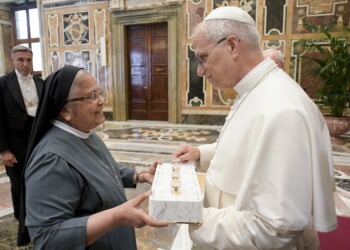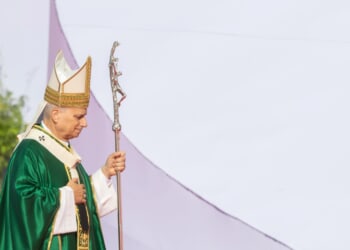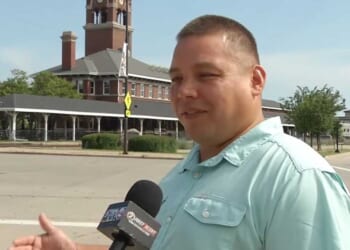A long, long time ago the governor of Alabama showed up in Cambridge, Massachusetts. This was back when I was young and the South was pretty rock-solid Democratic and years before Claudette Bateau and Sony Gay left Haiti for the U.S. and met and had their only child, a daughter. We’re speaking of George Wallace. He’d been a B-29 crewman in the Good War, World War Two, a Golden Gloves boxer, and run and won as a Democrat on a platform of justice for the little man and segregation now, segregation tomorrow, segregation forever.
Running for president again in 1972 he’d be shot by a white loner and paralyzed below the waist like FDR before the Salk and Sabin vaccines.
Once elected he’d stood at the entrance of the University of Alabama defying President John F. Kennedy, Democrat, Navy and Marine Corps Medal, Purple Heart, Harvard class of ’40, trying to stop one young Negro man and one young Negro woman — they were called Negroes then, including by themselves, including by Martin Luther King, Jr. — from registering. Kennedy had ordered the 2nd Infantry Division to be ready to enforce the Supreme Court-ordered integration of the school. “The Stand in the Schoolhouse Door” the governor’s unsuccessful but name-making show was known as.
Having put it on he announced early in the fall of 1963 that he’d be swinging through the northeast to make his views on important issues known and look into support for him as a candidate in the next year’s presidential elections. The Harvard-Radcliffe Young Democrats quickly extended an invitation, with the understanding that rather than making a speech he’d debate with a Harvard professor.
No, the governor wouldn’t do that, said his press secretary, because there was nobody on the faculty “of his stature.” This led Mark DeWolfe Howe, class of ’28, professor of law and Wallace’s prospective opponent in a televised debate, to say that since the governor was “unwilling to be answered” the invitation should be withdrawn.
“If he won’t appear and answer questions,” said Howe, “then he becomes simply a display — a dancing bear. It would be irresponsible for students to have him come just to watch the bear stand and scratch himself…. I think we owe something to the Negroes of the country and particularly of the South who see this man as a collaborator in killings.”
Howe was referring to the Ku Klux Klan bombing a month before of the 16th Street Baptist church in Birmingham. Four little Negro girls had been murdered.
Jefferson Frazier, class of ’64, president of the Young Democrats, agreed: “It would not be appropriate for Wallace to speak alone.” A 6-5 majority of the club’s executive committee thought so too. But the minority led by second vice-president Burt L. Ross, class of ’65, wasn’t convinced, and after two new members were elected to the committee it overrode Frazier and renewed the invitation on the governor’s terms — except that he’d also be fielding questions.
Ross & Company’s motives were impugned by Allen T. Rozelle and Gordon M. Wheeler, both class of ’66, in a letter to the Crimson, the student newspaper. They gave the free speech argument short shrift, declaring the club should be more concerned with civil rights than with giving Wallace a soapbox, especially as his opinions were already well known. Rather, they claimed, the capitulation was because the club’s treasury stood to profit handsomely from the governor’s one-night stand.
Academic, for by now he was in town.
The event was held in November in Sanders Theater under the same roof as Memorial Hall.
Let’s consult Wikipedia, back then an unimaginable resource:
Memorial Hall, immediately north of Harvard Yard in Cambridge, Massachusetts, is an imposing High Victorian Gothic building honoring Harvard men’s sacrifices in defense of the Union during the American Civil War — a symbol of Boston’s commitment to the Unionist cause and the abolitionist movement in America.
Built on a former playing field known as the Delta, it was described by Henry James as consisting of “three main divisions: one of them a theater, for academic ceremonies; another a vast refectory, covered with a timbered roof, hung about with portraits and lighted by stained windows, like the halls of the colleges of Oxford; and the third, the most interesting, a chamber high, dim and severe, consecrated to the sons of the university who fell in the long Civil War.
“The Memorial Transept consists of a 60-foot-high gothic vault above a marble floor, with black walnut paneling and stencilled walls, a large stained glass window over each of two exterior doors, and—commemorating the 136 Harvard men who died fighting for the Union—twenty-eight white tablets to one after another of the many who thus died—a thrilling list. One sees such old New England names as Peabody, Wadsworth, and Bowditch; one sees the name of Fletcher Webster; one sees that an Edward Revere died at Antietam and a Paul Revere at Gettysburg.
“Confederate deaths are not represented.”
The night of the speech and the questions and answers you had protestors outside, mainly white, singing civil rights songs and toting signs, one reading “Mr. Wallace, the Civil War is over. You lost.” Sanders — the biggest lecture hall on campus, acoustically marvelous, where Churchill had orated — was SRO. Precious few Negroes at Harvard then from the South, from the North, from anywhere. Just two I knew to say hello to, both foreigners: Chris Ohiri, class of ’64, an ever-cheerful Nigerian, make that an ever-cheerful Igbo soccer phenomenon, and Ayi Kwei Armah, class of ’63, a preppie, a Grottie like Franklin Delano Roosevelt class of ’03. Groton the WASPiest of all WASP prep schools. Armah, a Ghanaian, later a novelist, had graduated Harvard in June and returned to Africa. Ohiri, a senior like me, was still around smashing Ivy League scoring records but I don’t remember seeing him in Sanders.
Onto the stage came Wallace, law professor Arthur Sutherland and Burt Ross ’65, vice-president of the Young Democrats. Sutherland, the moderator, said he was happy Wallace was there and Harvard had offered him the chance to present his views, unpopular as these might be. The professor recited a short biography, turning from the governor to the audience and back again with maybe just a trace of irony in his voice. Wallace smiled, fingering his speech, once or twice smoothing his pompadour.
If anyone was expecting nonstop fire-eating he was in for a disappointment. America’s best-known defender of states rights was cajoling, homey, quick, pugnacious, disarming. True, he said in the North as in the South integration meant nothing but trouble. And true, he had no use for the 1954 Supreme Court school integration decision — Brown v. Board of Education. He blasted the judges, blasted the NAACP, claimed the amicus brief of the Negro sociologist Kenneth Clark was at odds with Clark’s findings on the emotional state of Negro children in segregated and integrated schools.
“Never in our history,” he said, “has it happened that the court lacks a single man distinguished as a lawyer before his calling to the bench.”
Brown v. Board of Education was unanimous, so Justice Hugo Black from Alabama’s dirt poor Clay County, an ex-member of the Ku Klux Klan, had to be one of these second-raters.
Never mind. Allowing for that plus language such as “usurpation of power by judges,” “judicial oligarchy along totalitarian lines,” “deceit in the rawest form,” the governor, a county judge once, didn’t simply play the racist as Mississippi governor Ross Barnett, another Democrat who’d visited, had in February. Actually when he interrupted himself he liberated many from their sense of reality.
WALLACE: (looking up from drinking a glass of water): It’s just water.
AUDIENCE: (Scattered chuckles).
WALLACE: You know, there’s some folks here from Alabama, and I know they like to be told what I’m drinking while I’m up here making a speech.
AUDIENCE: (Appreciative roar).
WALLACE, SUTHERLAND, ROSS: (Broad smiles).
By question time he’d so captivated a bunch of liberals seeing and hearing Willie Stark of All the King’s Men by Robert Penn Warren in the flesh that it took an effort to remember that mass arrests, troop call-ups, riots, and bombings revolved around him.
As each questioner came to a microphone to pose a killer, and walked away deflated, it became clear that Wallace was invulnerable.
To a Negro identifying himself as Gordon O. DuBois II, grandson of the belated nationalist, he drawled: “Between you and me both, we might kick out that crowd down in Washington. Maybe we should run on the same ticket.”
A student from Malaysia: “Why do you keep embarrassing your diplomats this way when America holds itself out as a champion of freedom?”
The governor: “We are for freedom and we’ve expended lives and money fighting for freedom all over the world. Instead of worrying about what they think of us they should worry about what we think of them.”
Some booing, some hissing — Wallace didn’t have everybody eating out of his hand. Yet at the end applause filled Sanders. Even the vandals outside were mannerly — instead of slashing the tires of his limousine they just let out the air.
Professor Sutherland a few days later, having given Wallace not even a gentleman’s C on his view of Brown v. Board of Education and Clark’s amicus brief, praised the audience’s conduct as a “great credit to the University. This was a fine example of civilized people listening to arguments with which they disagree.”
And Burt Ross summed up: “The overwhelming support of the governor’s right to talk is a glowing testimony to Harvard and to the fact that our motto — Veritas — lives on.”
Mere weeks later Kennedy visited Dallas. He was murdered, his brains were blown out, by a white Marine Corps veteran, who in turn was murdered, live on TV, by a white Jewish strip club owner and small time gangster.
A lot has changed and happened in the 62 years since that November.
From a Crimson item published in 1966:
Three services will be held this week in remembrance of Christian L. Ohiri ’64, who died of lung cancer at his home in Owerri, Nigeria, last Monday.
Ohiri, called “the greatest soccer player ever at Harvard” by Coach Bruce Monro, was 28.
Today there will be a service in Memorial Church at 2 p.m. Requiem masses will be held at St. Mary’s Church, Melrose, tomorrow at 7:30 a.m., and at St. Paul’s Church, Cambridge, Thursday, at 5 p.m. Ohiri sang in the choir at St. Paul’s.
The first sign of lung cancer came this summer, when Ohiri collapsed while playing tennis at the Harvard Business School.
While attending Harvard under the Afro-American Scholarship program, Ohiri set every scoring record in the Harvard soccer book: game (five goals), season (17 goals), career (47 goals) — even though he missed much of his sophomore and junior seasons because of leg injuries. As a freshman, he scored 36 goals in nine games.
Ohiri also holds the Harvard and IC4A track records for the triple jump and the Briggs Cage record for the broad jump.
Unmentioned would be the fact that when Ohiri went home to die the Igbos, his tribe, mainly Christian, were seceding from the rest of Nigeria, mainly Moslem, and trying to set up their own nation-state, Biafra. The number of Igbos who died of starvation in the Black-on-Black genocide following was between half a million and two million.
A current entry in Wikipedia:
The Biafra Zionist Front (BZF), formerly known as the Biafra Zionist Movement, is a group agitating for the restoration of Biafra and its independence from Nigeria. It is led by Benjamin Onwuka. The movement’s purpose is the actualization of the sovereign state of Biafra along precolonial lines.
The group claims to be supported by Israel and the United States, and Zionism is the official ideology of the organization.”
As for Wallace, two years after his Cambridge evening he ordered the Alabama state police to keep voting rights marchers from crossing a bridge in Selma. The result was Bloody Sunday complete with dogs, horses, beatings, and cattle prods. And in 1968, running for president, he carried Alabama, Arkansas, Louisiana, Mississippi and Georgia.
But that wouldn’t be all. Running for president again in 1972 he’d be shot by a white loner and paralyzed below the waist like FDR before the Salk and Sabin vaccines. It wouldn’t keep him from being reelected governor. But in time he came to Jesus, sincerely came to Jesus, embracing justice for the little man and little woman regardless of color, apologizing to his Negro, make that African American, make that black, make that Black fellow Alabamians, getting, in his last and winning run for the state house more than nine of 10 of their votes.
George Wallace died in 1998 — the same year Claudine Gay received a Ph.D. from Harvard.
READ MORE from Edward Grossman:




![Gavin Newsom Threatens to 'Punch These Sons of B*thces in the Mouth' [WATCH]](https://www.right2024.com/wp-content/uploads/2025/08/Gavin-Newsom-Threatens-to-Punch-These-Sons-of-Bthces-in-350x250.jpg)
![ICE Arrests Illegal Alien Influencer During Her Livestream in Los Angeles: ‘You Bet We Did’ [WATCH]](https://www.right2024.com/wp-content/uploads/2025/08/ICE-Arrests-Illegal-Alien-Influencer-During-Her-Livestream-in-Los-350x250.jpg)








